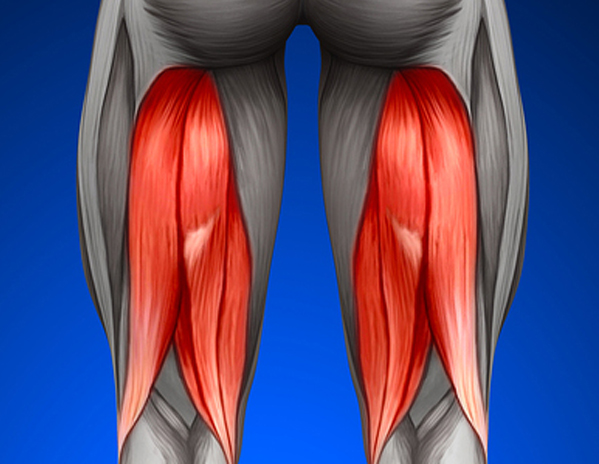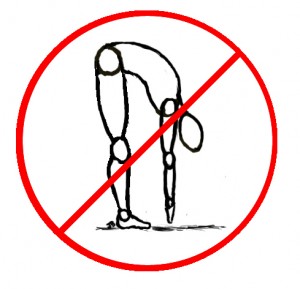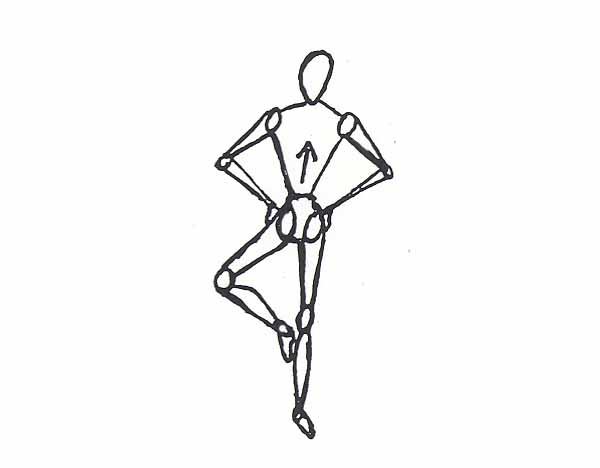Understanding Stretching – Active Muscle Stretching – Part 4 of 4
Active Muscle Stretching
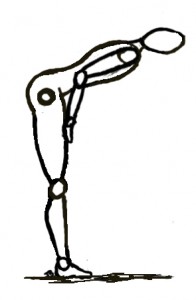 One of the best ways to have greater flexibility, less muscle tightness and improved joint health is to workout our body in a way that encourages our muscles to lengthen easily. As I stated previously, our muscle strengths and lengths respond to the conditioning we give to them. Most of the time however, we are unconscious of the demands we place on our body. Demands such as frequent or prolonged seated positions which shorten the hip flexors and hamstrings. Think of it this way, if for 8 hours or more per day we tell our hip flexors and hamstring muscles to be in a 90 degree bent position they are going to assume that this position is important to our survival. They are going to adapt to this condition, because after all, this is what we do day after day after day. When we come out of this position, we can straighten our knees and hips, but they are ready to bend again. They are pre-shortened, ready and willing to do more sitting for us. One of the dangers of sitting for long periods throughout our lives is that eventually, it will become harder to straighten these joints.
One of the best ways to have greater flexibility, less muscle tightness and improved joint health is to workout our body in a way that encourages our muscles to lengthen easily. As I stated previously, our muscle strengths and lengths respond to the conditioning we give to them. Most of the time however, we are unconscious of the demands we place on our body. Demands such as frequent or prolonged seated positions which shorten the hip flexors and hamstrings. Think of it this way, if for 8 hours or more per day we tell our hip flexors and hamstring muscles to be in a 90 degree bent position they are going to assume that this position is important to our survival. They are going to adapt to this condition, because after all, this is what we do day after day after day. When we come out of this position, we can straighten our knees and hips, but they are ready to bend again. They are pre-shortened, ready and willing to do more sitting for us. One of the dangers of sitting for long periods throughout our lives is that eventually, it will become harder to straighten these joints.
I am talking in the above situation about the hips and hamstrings, but the same conditioning occurs in all muscles and joints of our body. What we do persistently and consistently creates the body in which we live. This is where yoga can be a great benefit. Yoga poses are designed to be different from our regular lives. They cross train the body in ways that our normal life actions do not require. However, when I am talking about yoga, I am talking about more than just passive stretching. As I outlined before, passive stretching is what we do when we put our body into a position that lengthens the muscles without creating any opposing muscle action. A hamstring stretch on our back using a strap is an example of one such stretch.
Often these days when people discuss their desire to do yoga they remark, “I want to stretch,” as if that is the entirety of what yoga has to offer. Let me ask you this. What if there was a way of working with your body so that every muscle was precisely tuned to your optimal flexibility? What if there was a system of action that brings every muscle throughout your body, every muscle length and every muscle strength, into harmony with one another? What if not only could you use this system to cross train your muscles to peak performance, but also reduce your stress levels, increase cellular oxygenation and enhance the neurological connection between your brain and your body? If your are interested in this, then you are interested in yoga – but a yoga that is more than just passively stretching your muscles. You are interested in a active yoga that has the power to transform your body and your life. For the sake of the conversation here we will just keep it simple and talk about how to transform your hamstrings through active stretching.
Active stretching is about enhancing muscle relationships. The goal of active stretching is to create a state of conditioning where a muscle on one side of a joint possesses an optimal length while its muscle partner on the other side of the joint possesses optimal strength. In order to understand active stretching, it helps to understand a little about muscle relationships. Let’s talk about the relationship between our tight hamstrings and their muscle partners.

Since it does not serve us the best to have a leg that only extends at the hip and flexes at the knee, nature has thoughtfully provided us with other muscles that do the exact opposite action of the hamstring muscles – in other words, they oppose the hamstrings. These hamstring opposers serve to flex the hip (bend it forward) and extend the knee (straighten it). 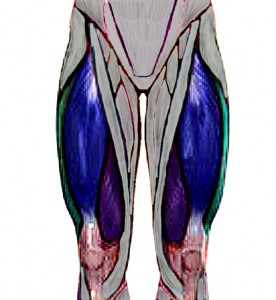
So, to summarize, the hamstring (back of the thigh) is opposed by the iliopsoas and quadriceps (front of the hip and thigh).
Neurologically, these muscles are distinct from each other. They have their own separate nerves and their own separate regions in the motor part of the brain. Yet, these muscles have a very involved relationship with one another. They monitor one another and respond to changes created by one another. Basically, when the hamstring muscles contract, special nerve structures relay this contraction through the spinal cord to the nerves of the iliopsoas and quadriceps causing these muscles to relax so they do not interfere with the action of the hamstring. The same is true for contractions of the iliopsoas and quadriceps. When they contract, the hamstring muscles relax.
This makes good sense if you want to do something like, oh, I don’t know, move your leg. If both muscles on opposite sides of the joint contract at the same time, movement will be restricted and possibly even prevented. Since historically, creatures that move are more likely to ‘get away’ from creatures that want to eat them, nature decided that this particular trait of contract/relax response, more formally known as reciprocal inhibition, should be passed on. So, this contract/relax response is hardwired into all of our muscle groups and they play the game of red light, green light with one another.
Active stretching uses the principles of reciprocal inhibition in order to enhance our muscle lengths and opposing muscle strength. Active yoga takes this concept and involves the person into a mindful state of selectively contracting opposing muscle groups in order to create efficient and effective joint range of motion. In other words, we learn to contract some muscles in order to properly lengthen other muscles. By emphasizing the natural hardwired principles of muscle control we can enhance our muscle relationships.
For you to better understand this contract/relax response we will again choose an example that involves the hamstring muscles.
Actively Stretching a Tight Hamstring
The following pose is the classic yoga forward bend, but done with a mindfulness of proper back posture, and elongated spine and emphasis on controlled contraction of the quadriceps muscles. Contraindications to the following action would be low back discomfort, disc issues, hamstring muscle strain or sprain, and hip flexor muscle strain or sprain. As with all exercise, be mindful of your body and do nothing that causes pain.
- Start in a standing position with your feet hip distance wide. Your hip distance is found by feeling for the bony front of your pelvis and aligning your knees and ankles beneath these points.
- Lift the front and back of your rib cage away from your pelvis. Throughout the following actions, keep aware of and maintain a long spine. Keep your breathing deep and slow.
- Tighten your thighs so that the front of your legs (quadriceps area) becomes firm from you knees to your hips. Concentrate on this sensation.
- Bend forward from your hips about 10 degrees. As you create this slight bend, make sure your lower back stays in its neutral position, curved slightly toward your navel and keep your spine long.
- Staying at the 10 degree forward bend, focus on creating a strong contraction in your quadriceps (front of thigh). It can really help to place your palms on your thighs and concentrate on making the muscles firm.
- If you can feel front of your leg sensation more than the back of your legs (hamstring area), you can proceed further. If you feel an equal sensation in both the front and back of the leg or if the back of the leg feels a stronger sensation than the front. Bend your knees and return to the starting position.
- If at 10 degrees you still can control the contraction in your quadriceps, bend forward another 10 degrees. At all times keep your lower back neutral, your spine long and your quadriceps tight. Keep your breathing deep and slow.
- Continue to progress forward until you feel a light sensation in the back of the legs. Hold this position if you can keep the sensation in the front of your legs stronger than in the back of your legs. If at any time you lose the neutral lower back curve, shorten your spine or feel the back of the legs more than the front of the legs, bend your knees and come out of the position.
- Remember, since the point of this pose is to create a change in the relationship of your muscles, the pose will probably not look like a traditional yoga pose you have done before without these steps. Focus on your actions and alignment.
- Always come out of your forward bend by bending your knees. This prevents you from using your hamstrings to lift your body upward.
- Practice this technique persistently and you will be rewarded with progress.
- Newcomers to this method of active stretching will often need to address the following:
- —– Avoid rounding the lower back. To protect the lumbar discs we must keep our lower back neutral, which means it curves slightly toward the navel.
- —– Avoid bending from the back instead of the hips. The area from the neck to the tip of the tailbone should be in a neutral posture. Create only the bend that you can from the hips. It is likely that you will not be able to bend forward very far in this manner at first.
- —– Keep a constant contraction in the quadriceps. Once we begin to bend forward we often lose connection to contracting the front of our leg. You can feel this by placing your hands on your thighs when your are upright and contracting and then comparing that firm sensation to the softness in the front of the leg after you bend forward. Pre-activation of the quadriceps with the seated leg lift can help.
- —– Allow only mild sensation in the hamstring area and stop when that sensation begins to increase. Sensation in the back of the leg indicates resistance to the stretch. As in passive stretching, the stronger this sensation becomes, the greater the muscles are contracting to prevent the stretch. It will take time and practice before your quadriceps contraction will overwhelm the resistance of your tight hamstrings. As long as the front of the leg sensation is stronger than the back of the leg sensation then you are making progress. If you let the back of the leg become overly sensational, your are reversing your progress.

When you practice in the above way you will find that your forward bend pose will likely be radically different from the pose you create when you are not mindful of the active stretching technique. Some may be unhappy with the lack of initial hamstring length they possess. It will take focused practice of the mindful technique and persistence to create a body environment where you will have a naturally longer hamstring. The good news is that once you begin to practice this way, your hamstrings will respond and they will remain longer as long as you continue to encourage them this way.
The same principle of active stretching can be employed in all dynamic yoga actions. Try it yourself and let me know what you think.
* Please stay healthy and injury free. This guide is not a replacement of common sense. Please consult with your medical doctor prior to doing exercise. Do nothing that causes you pain. *
Part 1 – Why are we tight?
Part 2 – Passive Muscle Stretching
Part 3 – Reinforcing Hamstring Muscle Length


